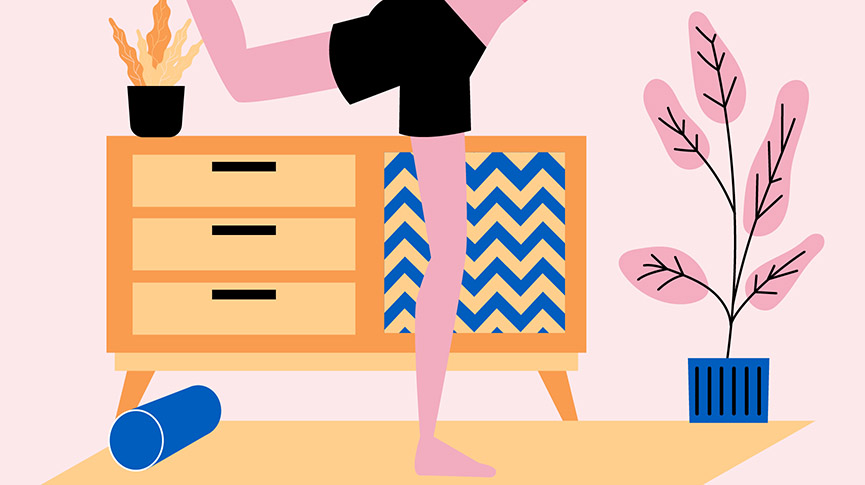9 Simple Ways to Protect Your Pelvic Floor During Exercise

This article was medically fact-checked by Consultant Obstetrician and Gynaecologist Dr. Shree Datta.
We’re big fans of staying fit and healthy, but it’s important to make sure your fitness routine is safe for every part of your body – including your pelvic floor muscles. Some exercises put increased downward pressure on it, which can weaken the muscles and connective tissues there.
Your pelvic floor supports your organs and helps control your bladder and bowel. A weak or damaged pelvic floor can contribute to pelvic floor disorders like incontinence and pelvic organ prolapse – so making sure it’s not strained during exercise is crucial to your health.
This shouldn’t be a reason to avoid exercise though. Moderate exercise and being healthy is beneficial to the pelvic floor, but it’s important to be aware of the risks and learn the techniques for strengthening and protecting your pelvic floor during exercise.
Riskier Exercises
Weight lifting, in some cases, has been shown to weaken or damage the pelvic floor, by creating abdominal pressure and putting more strain on the muscles of the pelvic floor. If you have symptoms of pelvic floor weakness we recommend that you talk to your doctor before taking up weight lifting.
For women with a healthy pelvic floor, there are methods to preemptively strengthen the pelvic floor and some simple things you can do while exercising to help you look after those muscles while continuing to work out any way that you like.
High impact and heavy lifting exercises, like running, gymnastics, and high-intensity interval training (HIIT) are mostly considered safe, but can also carry a small amount of risk. Again, if you have preexisting pelvic floor disorders, we advise talking to your doctor before starting a new workout program.
At the same time, depending on someone’s body type, excess weight can potentially cause damage to the pelvic floor because of added pressure. Exercise is helpful in managing weight in a healthy manner and keeping that pelvic floor in good shape. Like anything – it’s a balance! You know your body best. If you feel like your workout routine is supporting your overall health, awesome!
It’s also worth mentioning, that if you’re a smoker, stopping that habit is one of the best things you can do for your pelvic floor health long term. Having a chronic cough puts an immense amount of strain on these muscles, potentially causing issues long term. Smoking also makes exercise more difficult!
Kegel Exercise – A Woman’s Most Essential Exercise
The most important thing you can do for your pelvic floor is to strengthen it using Kegel exercises – simple contract and release movements of your pelvic floor muscles. You’re toning your thighs and building strength in your biceps, right?
So you should also take a few minutes each day to keep your pelvic floor toned as well. There are even pelvic floor exercise devices that act like a personal trainer, keeping track of your progress and automatically setting your routine each session according to your strength level.
Pelvic Floor Safe Exercise Techniques
According to physiotherapist and author Michelle Kenway, the key to making your exercises pelvic floor safe is to lower the amount of stress placed on your pelvic floor muscles. If you already have pelvic floor problems we recommend talking to your doctor, a trained fitness professional, or a women’s health physiotherapist to create a tailored fitness plan. Even if you don’t have pelvic floor issues, these tips adapted from Kenway’s book Inside Out can help you avoid future problems:
1) Alternate Fitness Activities. If you are following a high impact routine, try to alternate those sessions with an exercise that focuses on core strength like yoga or Pilates, which can simultaneously strengthen the pelvic floor and let it rest a bit.
2) Don’t Hold Your Breath. Holding your breath keeps the pressure level high and even increases your blood pressure. Instead, breathe out with each effort (like pushing, pulling, or lifting).
3) Engage Your Pelvic Floor. During each effort gently contract your pelvic floor muscles and relax afterward (effectively do a gentle Kegel contraction). This adds a little more support during exercise and ensures that you’re aware of your pelvic floor during periods of higher stress.
4) Stabilize Your Abdomen. Choose resistance exercises or positions that keep your abdomen and pelvic floor supported. When using hand weights you can sit on an exercise ball, which engages your abdominal muscles. Or you can use seated machines with adjustable weights, which support your abdomen as you do the exercise.
5) Use Correct Posture and Form. Correct posture and form ensures that you’re not only doing the exercise correctly each time and getting the most out of every repetition but also that you don’t injure yourself.
6) Reduce the Depth of Squats or Lunges. Try to keep your hips higher than your knees, so you can maintain better control over your pelvic floor.
7) Keep Your Legs Close Together. Wide stances make it more difficult to engage and control your pelvic floor muscles. During each repetition keep your feet about hip-distance apart.
8) Choose Pelvic Floor Safe Core Exercises. Abdominal exercises can be some of the most stressful for your pelvic floor, but certain types of core exercises are gentler and put less downward pressure on your pelvic floor. Find a routine that tones the muscles you’re targeting, but give your pelvic floor a break.
9) Start Slowly. Exercising too intensely isn’t good for your body or pelvic floor. You can gradually increase your hold times and the number of reps per set over time – but start with a lower number at first and be sure to rest between sets.
Reaching your fitness goals doesn’t have to come at the expense of your pelvic health. Protecting your pelvic floor during exercise just requires exercising safely and choosing your routine carefully (sometimes with the help of a doctor or fitness professional).
Being aware of your body and paying attention to your pelvic floor is essential to keeping it healthy and strong throughout your lifetime – just like all of your other muscles.
Facts checked by:
Dr. Shree Datta
Dr. Shree Datta is a Consultant Obstetrician and Gynaecologist in London, specialising in women’s health including all menstrual problems such as fibroids and endometriosis. Dr. Shree is a keen advocate for patient choice, having written numerous articles and books to promote patient and clinician information. Her vision resonates with INTIMINA, with the common goals of demystifying periods and delivering the best possible care to her patients
Written by:

A collective group of “lady experts” at Intimina who love sharing our personal experiences, even when they are a little too personal. We believe it’s time to start breaking down the taboos around menstruation, motherhood, and menopause, and start owning our female health.



